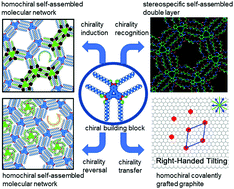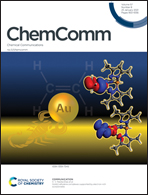Chirality in porous self-assembled monolayer networks at liquid/solid interfaces: induction, reversion, recognition and transfer
Abstract
Chirality in two dimensions (2D) has attracted increasing attention with regard to interesting fundamental aspects as well as potential applications. This article reports several aspects of supramolecular chirality control as exemplified by self-assembled monolayer networks (SAMNs) formed by a class of chiral building blocks consisting of a triangular conjugated core and alkoxy chains on the periphery. It highlights 2D chirality induction phenomena through a classic “sergeants-and-soldiers” mechanism, in which the inducer is incorporated into a network component, as well as through a “supramolecular host–guest” mechanism, in which the inducer is entrapped in the porous space, leading to counterintuitive chirality reversal. Stereochemical control can be extended to three dimensions too, based on interlayer hydrogen bonding of the same class of building blocks bearing hydroxy groups, exhibiting diastereospecific bilayer formation at both single molecule level and supramolecular level arising from orientation between the top and bottom layers. Finally, we showcase that homochiral SAMNs can also be used as templates for the grafting of in situ generated aryl radicals, by covalent bond formation to the basal graphitic surface, thereby yielding topologically chiral functionalized graphite, and thus extending the potential of chiral SAMNs.



 Please wait while we load your content...
Please wait while we load your content...